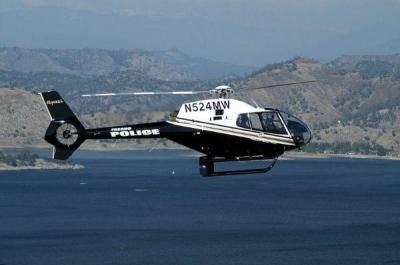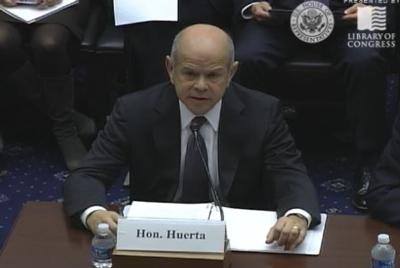Believed To Be the Longest Sentence Ever Imposed In A Laser-Strike Case
Sergio Patrick Rodriguez, 26, of Clovis, CA, has been sentenced to 14 years in prison for aiming a laser pointer at Fresno police helicopter Air 1 (pictured), and attempting to interfere with its operation, according to United States Attorney Benjamin B. Wagner. Calling him a “walking crime spree,” United States District Judge Lawrence J. O'Neill said the crime was serious with potentially deadly consequences.

Rodriguez and his girlfriend, Jennifer Lorraine Coleman, 23, were both convicted by a federal jury after a three–day trial in Fresno, CA in December 2013.
According to evidence presented at trial, Rodriguez and Coleman used a high-powered green laser pointer to repeatedly strike the cockpit of Air 1 during a clear summer night in 2012. Air 1 had responded to the apartment complex where Rodriguez and Coleman resided near the Fresno Yosemite International Airport to investigate the report of laser strikes on Air George, an emergency transport helicopter for Children’s Hospital of Central California. The laser pointer that Rodriguez and Coleman used was 13 times more powerful than the permissible power emission level for hand-held laser devices. The crew members of both Air 1 and Air George testified that the laser strikes caused significant visual interference.
In imposing the sentence, Judge O’Neill considered not only the severity of the offenses but Rodriguez’s significant criminal history, numerous probation violations, and Bulldog gang affiliation. In addition, Dr. Leon McLin, a Senior Research Optometrist for the Air Force Research Laboratory who testified at trial, indicated at sentencing that the laser pointer that Rodriguez used was an instrument capable of inflicting serious bodily injury and, indirectly, death due to a high potential for crash caused by visual interference.
“We in federal law enforcement understand the dangers posed by laser strikes on aircraft,” U.S. Attorney Wagner stated. “This is not a game. It is dangerous, and it is a felony. Those who aim lasers at aircraft should know that we will seek to convict them, and we will seek to send them to prison. The safety of aircraft and the people in them demands no less.”
“Lasing aircraft is not a joke or a casual prank. It is reckless behavior that can have fatal consequences for air crew, passengers and the public on the ground,” said Special Agent in Charge Monica M. Miller of the FBI’s Sacramento field office. “Rodriguez’s sentence clearly demonstrates the seriousness of his actions and that the FBI will work with its law enforcement partners to locate and arrest those who engage in dangerous, improper use of hand-held lasers that puts us all at risk.”

“Deliberately pointing a laser at an aircraft is a criminal act with serious safety repercussions,” said FAA Administrator Michael Huerta (pictured). “We applaud law enforcement agencies and the U.S. Attorney's Office for their efforts to combat this serious problem.”
This case is the product of an investigation by the Federal Bureau of Investigation with assistance from the Clovis and Fresno Police Departments, the Federal Aviation Administration, and the National Institute of Standards and Technology of the U.S. Department of Commerce. Assistant United States Attorneys Karen A. Escobar and Michael G. Tierney are prosecuting the case.
Sentencing for co-defendant Coleman is set for May 12, 2014. She faces a maximum statutory penalty of five years in prison and a $250,000. The actual sentence, however, will be determined at the discretion of the court after consideration of any applicable statutory factors and the Federal Sentencing Guidelines, which take into account a number of variables.
According to the FAA, there were 3,960 reports of people shining lasers at aircraft in the United States in 2013. The Eastern District of California, which encompasses 34 counties in the eastern portion of California, reported 94 laser strikes, with the largest number of laser incidents reported by the Fresno Yosemite International Airport and Bakersfield Meadows Field Airport. Law enforcement and emergency transport helicopters are particularly vulnerable, since they typically fly at lower altitudes. Their convex-shaped windows also cause greater refraction and visual interference when the beam of a laser strikes. Night-vision goggles can also amplify the beam and pose a greater threat of visual interference.
On February 11, 2014, in 12 cities, the FBI, in collaboration with the Air Line Pilots Association International and the FAA, announced the Laser Threat Awareness campaign, a nationwide effort to alert the public to the threat that aircraft laser illumination poses and the penalties for such activity. The FBI will offer up to $10,000 for information leading to the arrest of any individual who intentionally aims a laser at an aircraft. If you have information about a laser strike, contact your local FBI office. Tips can also be submitted online. If you see someone pointing a laser at an aircraft, call 911.
 Senator Pushes FAA to Accelerate Rocket Launch Licensing
Senator Pushes FAA to Accelerate Rocket Launch Licensing Classic Aero-TV: RJ Gritter - Part of Aviations Bright New Future
Classic Aero-TV: RJ Gritter - Part of Aviations Bright New Future Aero-FAQ: Dave Juwel's Aviation Marketing Stories -- ITBOA BNITBOB
Aero-FAQ: Dave Juwel's Aviation Marketing Stories -- ITBOA BNITBOB ANN's Daily Aero-Linx (10.27.24)
ANN's Daily Aero-Linx (10.27.24) ANN's Daily Aero-Term (10.27.24): Clearance Void If Not Off By (Time)
ANN's Daily Aero-Term (10.27.24): Clearance Void If Not Off By (Time)




